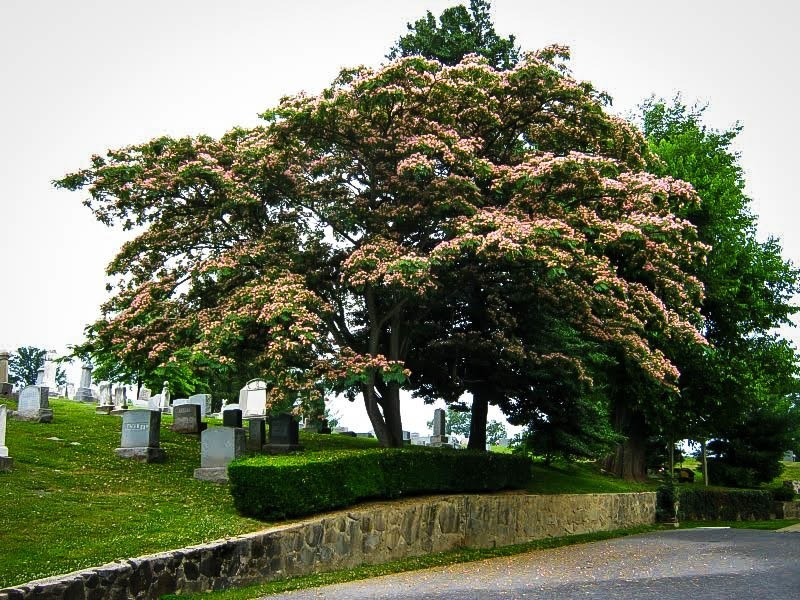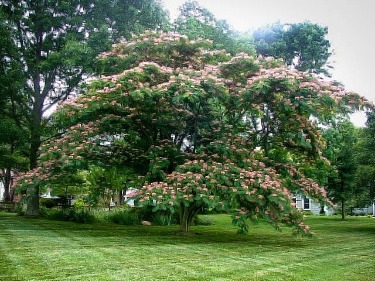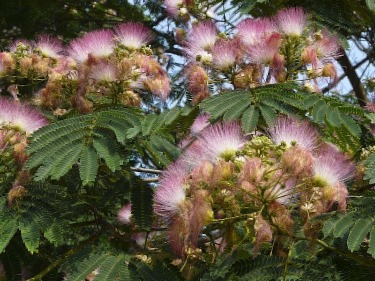What Does a Baby Mimosa Tree Look Like
Gardening Tips For The Mimosa Tree
The Mimosa Tree is a stunning prove of flower bursts, which are often compared to starbursts or fireworks. This small to medium-sized fast growing Mimosa Tree displays the virtually beautiful pink flowers in the depths of summer. Butterflies, bees, and hummingbirds will flock to these flowers, which show off bright, tight clusters of pink to yellow-tipped stamens. Frequently known every bit the "silk tree", the stamens of the flower are reminiscent of silk threads. The Mimosa Tree has unique palmate leaves, which announced as tiny fronds similar to the leaves of palm copse or fern plants. Texture is a large attribute of why the Mimosa Tree has gained popularity throughout the United States. The twenty to xxx pocket-sized leaflets provide a detailed background on which the bursting colors of the Mimosa blossom blossom.
The Mimosa Tree is known past many other names throughout the world. Its Italian namesake, Filippo degli Albizzi, provides it a portion of its scientific proper noun, Albizia julibrissin. The other part of the proper noun is derived from a Western farsi word meaning "silk flower". Commonly institute throughout the world's warmer climates, the Mimosa Tree is a popular ornamental flowering tree. It is also fast-growing, making information technology an irresistible pick for many homeowners. For gardeners hoping to provide dappled shade for smaller plants, the twenty to 25 foot alpine Mimosa Tree provide the necessary summit, shape, and leave density. It is ever a beautiful add-on to the garden.

These drought-resistant and fast-growing copse exercise produce beautiful flowers, which when coupled with its small fruit and leaves, tin create the need for a clean-up routine. Well worth the clean-up and pruning, Mimosa Trees are positively beautiful when planted as either a key focal point in the grand or in a row equally a border along entryways or fences. Enjoy the luscious pink blossoms in summertime and the gentle shape throughout the yr.
Quick Tips
Savor some quick tips here. For more complete data, read about these hints in more item beneath.
Sunlight – Mimosa Copse prefer full lord's day; in drier regions, some partial afternoon shade for the tree may evidence benign.
Soil – The adjustable Mimosa Tree prefers moist, well-tuckered acidic soil; nevertheless, the tree is often successful in a variety of other soil atmospheric condition.
Water – The drought-tolerant Mimosa Tree prefers at least an inch of h2o a calendar week; even so, it is able to withstand balmy to moderate droughts with relative ease.
Pruning – Pruning should occur in winter, while the tree is dormant only after information technology is established (3 years). Remove dead or diseased forest.
The Best Places to Plant the Mimosa Tree
 The Mimosa Tree, which originated in southwestern and east asia, prefers the warmer climates. The tree is now unremarkably found throughout many regions of the world, and it tin withstand brief cold spells.
The Mimosa Tree, which originated in southwestern and east asia, prefers the warmer climates. The tree is now unremarkably found throughout many regions of the world, and it tin withstand brief cold spells.
In the United States, the Mimosa Tree prefers USDA Hardiness Zones six through 10, preferring the subtropical to tropical climates of much of the lower latitudes. Plant the Mimosa Tree in an surface area that receive full dominicus, though some fractional shade, especially in the driest regions of the southwest, tin can exist helpful to the water retentivity of the tree. The Mimosa Tree is best suited equally an accent plant, where its ornamental beauty will not exist lost. For many gardeners, this may mean a center-garden or center-m spot. The Mimosa Tree can likewise be used to line entryways or driveways, and its uniform shape allows it to pair nicely with others in its species.
Mimosa Copse adopt the moist, well-tuckered soil typical of loam. With regard to pH, the tree enjoys slightly acidic soil. Despite these preferences, the Mimosa Tree readily adapts to diverse soil weather condition. H2o is not as much of a concern for the Mimosa Tree. In fact, short dry spells volition not harm this tree since information technology is drought-resistant. Like most flowering trees, the Mimosa prefers at least an inch of water a week in the form of rainfall or irrigative services. If the region in which the tree is planted is prone to severe droughts, consider investing in an irrigation arrangement that will not but help command the flow of water, but disperse it to the Mimosa during those truly hot, long-lasting droughts.
The Mimosa Tree is a beautiful ornamental found. When considering planting locations, look for one where its beauty will shimmer!
Growth Rate and Mature Height
The Mimosa Tree is a modest to medium sized ornamental tree. It is besides exceptionally fast-growing. Expect the tree to rapidly reach between 20 and 25 feet in top and ten to 20 anxiety in width. The growth rate of the tree is fast, frequently earning the Mimosa Tree as much every bit five anxiety in a growing season!
Pests, Diseases, and Other Concerns

The Mimosa Tree is known to be a hardy, disease-resistant ornamental tree. Despite these benefits, there is one vascular fungal illness that tin affect the growth of the Mimosa Tree. Mimosa Wilt is the virtually fatal of the diseases to bear on the Mimosa Tree. The leaves of the Mimosa will yellow and wither before midsummer, oft interrupting flowering. Many trees die quickly after wilting is observed, though virtually die branch by branch.
Diseased trees in advanced stages of the disease's development may produce ooze from cracks in the trunk. Using a balance fertilizer tin can assistance to reduce the likelihood of the Mimosa developing this wilt. Water oft and remove diseased wood.
Noteworthy Tips on the Mimosa Tree
– The Mimosa Tree has several cultivars that have get popular, including the 'Summer Chocolate' and 'Ishii Weeping'.
– Mimosa Trees produce seeds that are enjoyed past many wild animals, including birds.
– In some regions of the world, such as Japan, the Mimosa Tree has been labeled 'invasive'.
– Birds, butterflies, and honeybees will flock to the sweet nectar the Mimosa Tree produces, adding a wildlife scene to the garden surroundings.
– The seeds grow readily, which is function of the reason the tree has been labeled as invasive in some areas. Researchers are currently cultivating a non-seed bearing Mimosa cultivar that will be able to provide the same stunning beauty without the risks!
Source: https://www.thetreecenter.com/mimosa-tree-complete-guide/
0 Response to "What Does a Baby Mimosa Tree Look Like"
Postar um comentário